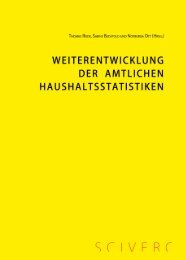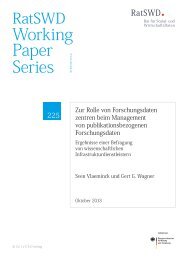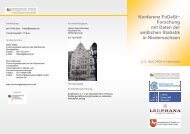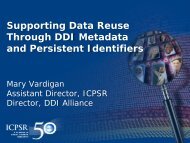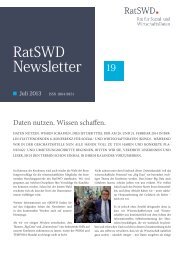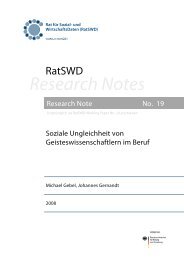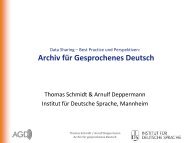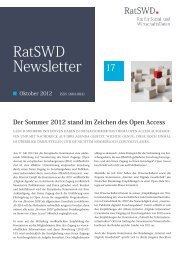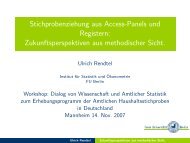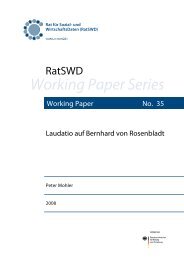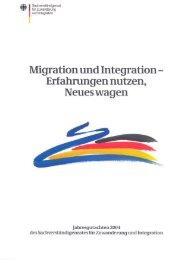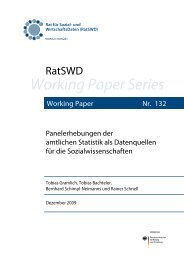The German Microcensus - RatSWD
The German Microcensus - RatSWD
The German Microcensus - RatSWD
Create successful ePaper yourself
Turn your PDF publications into a flip-book with our unique Google optimized e-Paper software.
<strong>The</strong> <strong>German</strong> <strong>Microcensus</strong> 653<br />
the European Union (ISCO 88-COM).<strong>The</strong> microcensus also allows the representation<br />
of international classifications in the field of education and<br />
training, for example the distribution of students in education and data on<br />
educational attainment of the adult population to the International Standard<br />
Classification of Education (ISCED).<br />
At regular intervals, the microcensus contains different supplementary<br />
questions, the so-called supplementary programme.This is laid down in the<br />
current <strong>Microcensus</strong> Law.For example in 1996, and again in 2000, the microcensus<br />
included questions on the journey to work (time, distance, transport),<br />
the position of employees in their enterprise and detailed questions<br />
about the field of study of persons with a university degree.<strong>The</strong> one percent<br />
dwelling survey was integrated in the microcensus in 1998.Variables were<br />
provided about the size, the ownership, the equipment and the costs of the<br />
dwelling.In 1999 the microcensus contained questions about individual<br />
health insurance and the personal health situation.<br />
An important advantage of the microcensus is the possibility to combine<br />
the variables of the supplementary programmes with all other variables.<br />
Special fields of interest can be analysed in connection with the socio-demographic<br />
background and detailed variables in the field of employment.<br />
Another major advantage of the microcensus is its representative basis for<br />
in-depth socio-demographic analyses.Analyses can be done also for individuals<br />
and in the context of the household or family.<strong>The</strong> data set contains a<br />
large number of variables, with specifications about the household and the<br />
family, produced from the information in the questionnaire.<br />
4. Data access<br />
<strong>Microcensus</strong> data are available in different ways.First of all, the Federal<br />
Statistical Office publishes several Subject-Matter Series every year:<br />
Subject-Matter Series 1:<br />
BevoÈlkerung und ErwerbstaÈtigkeit (Population and Employment)<br />
Series 4.1.1.: Stand und Entwicklung der ErwerbstaÈtigkeit<br />
(State and Development of Employment)<br />
Series 4.1.2.: Beruf, Ausbildung und Arbeitsbedingungen der ErwerbstaÈtigen<br />
(Occupation, Training and Working Conditions of Economically<br />
Active Persons)<br />
Schmollers Jahrbuch 121 (2001) 4



